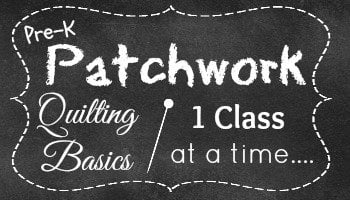For me, the fabric grain is one of the most confusing parts! I usually just snatch up some fabric because I like it. I pay no attention to the grain…just look at the pretty colors.
I find though, that when I get it home and start cutting -the edges are gone…I have no idea where the bias is or the crosswise grain or anything else for that matter!
Today we will go over all those technical terms and learn what fabric is all about so we don’t get all mixed up.

Let’s start with the facts: Fabrics are woven in two different directions. We call them the lengthwise and crosswise grains. Although there’s only two directional weaves, we have three grain lines.
The term fabric grain refers to the way threads are arranged in a piece of fabric. Grain is one of those quilting topics that you might not think is important, but the way you cut your quilting patches in relation to the grain can produce quilt blocks that are accurate and easy to assemble–or blocks that just won’t do what you want them to do.

What are the three grain lines of fabric?
The lengthwise grain runs parallel to the selvages. It’s the strongest grain in your fabric. They are also the longest threads- and called the warp threads. These do not stretch.
The crosswise grain runs at a right angle to the selvages. It has a bit more stretch than the lengthwise grain. These threads are also known as the weft threads. They are woven back and forth, perpendicular to the warp thread. This has a slight stretch to it.
The bias grain runs on a 45-degree angle to the selvages. It has the most stretch, so it distorts easily. You must be careful when handling the bias. Usually refered to any cut that doesn’t run along a straight grain -it’s a bias cut.
There is also the Selvage….
Selvages
Selvages are the bound edges that run along the outermost lengthwise grain. They are formed when the weft threads turn to change direction as the weaving process travels down the warp. Fabrics are very tightly woven for a half-inch or so from the selvages inward, keeping the edges stable while fabric is on the bolt. If you notice- these edges have a different texture, do not fray and often have a manufacturing stamp on them.
So, What’s so important about fabric grain? Why do quilters/sewers need to know this?
When you are piecing a quilt you will find that some quilt block pieces are stretchy and get all wacked out of shape. This {for the most part} is because of the fabric…not because of your sewing! Half square triangles are the biggest offender. They love to stretch their bias out and make a whole bunch of mess with your quilt top.
Here are some hints to help you with the bias:
- When sewing with these bias edges, you will need to pin, pin, and then pin some more.
- Make sure you don’t pull your fabric when stitching them with the sewing machine.
- When you are pressing them with the iron- don’t drag the iron over them pulling the fabric. Press firmly from the top and don’t wiggle too much.
The other grains don’t give as much problems, but you will find you know when you are sewing with the warp or lengthwise threads– there is NO GIVE! so, again…use pins!
Q & A: How do you handle the grains when sewing/quilting? Any tips, hints you’d like to add to the conversation? Let’s talk about it!
Need a reminder to stop by and join the discussion? I’d love to send you an email nudge…sign up here!


Becky Jorgensen is the creative quilter behind Patchwork Posse, the Patchwork Planner and her online quilt group Patchworkers Plus. You can find her patterns in books, magazines, and her quilt membership. Gather your quilting supplies, organize your sewing space, explore the process of disappearing quilt blocks, or finish a free quilt pattern. I'll help you use what you have, finish what you start and make your quilting journey fun!
Follow me here: Facebook, Pinterest, YouTube







Thanks for the helpful tips….seems like my edges never line up when I get the fabric home…..this helps!
Many thanks for the great fabric grain tips you made is very easy to understand 🙂